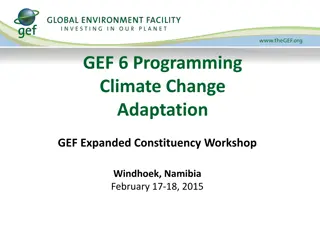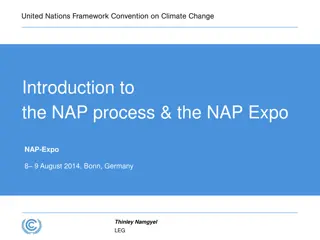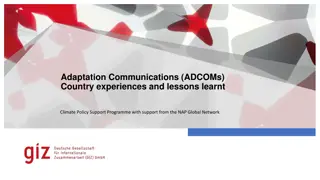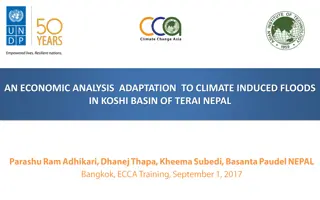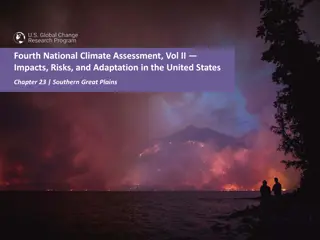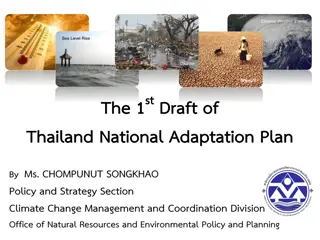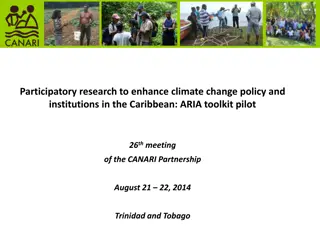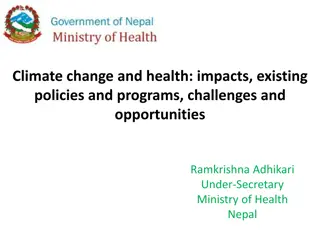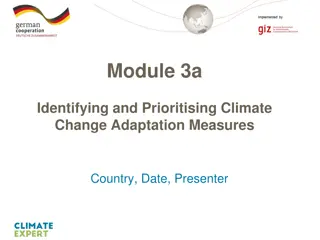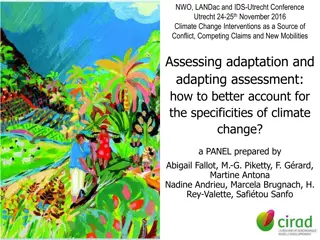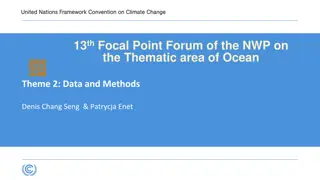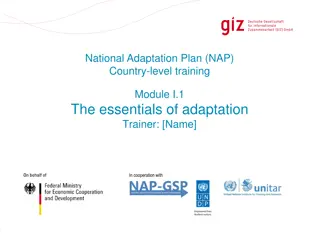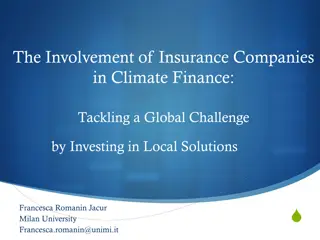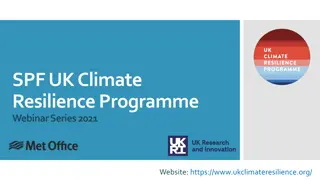Climate Change Impact Analysis and Adaptation Strategies in WG Meeting
In the FAO-IGG inter-sessional meeting of October 2015 in Milan, WG on Climate Change discussed data collection, vulnerability analysis, and adaptation strategies. They focused on climate trends, impact analysis, adaptation projections, and strategies like tree establishment, crop diversification, and land management to combat climate change effects.
Download Presentation

Please find below an Image/Link to download the presentation.
The content on the website is provided AS IS for your information and personal use only. It may not be sold, licensed, or shared on other websites without obtaining consent from the author. Download presentation by click this link. If you encounter any issues during the download, it is possible that the publisher has removed the file from their server.
E N D
Presentation Transcript
FAO-IGG inter-sessional meeting (Milan, October 15-16, 2015) WG on CLIMATE CHANGE WG on CLIMATE CHANGE Chair: Co-Chairs: India Sri Lanka - Dr. M.A. Wijeratne Kenya Dr. J. Bore Dr. R.M. Bhagat Members: China Japan Tanzania Malawi Bangladesh Rwanda Indonesia
ACTION PLAN Data collection and analysis to be continued. Analysis of vulnerability /suitability with IPCC, AR 5 scenarios to continue. Collate and combine adaptation strategies common to all WG countries along with country specific strategies. Publish a booklet on adaptation strategies common to all countries in English and release it in the next FAO-IGG meeting. Translation of the booklet into different country specific languages. Implementation of adaptation strategies on pilot scale in each country & impact analysis.
1. Impact Analysis: Climate trends Annual total Rainfall, 1918-2014, Jorhat, Assam, India Rainfall
Mann - Kendall Model test for climate trends Mann Kendall Statistic (S) P-Value (Two- tailed) Kandell tau Sen's Slope Test Parameter Mean SD Var(S) Alpha Interpretation Reject Ho Sig.trend 2000.5 252.1 -820.000 -0.176 102949.3 0.011 0.95 -2.397 Rainfall Reject Ho Sig.trend Minimum Temperature 18.762 0.561 2483.0 0.594 87901.0 <0.0001 0.95 0.018 Relative Humidity (Morning) Reject Ho Sig.trend 93.730 1.071 -33.0 -0.021 21060.3 0.825 0.95 -9.062E-4 Relative Humidity (Afternoon) Accept Ho No trend 64.349 1.741 -10.000 -0.006 21074.6 0.951 0.95 0
2. Projections 2100 AR 5 Scenarios
3. 3. Adaptation strategi Adaptation strategies es Establishment Establishment and shade shade trees trees and management management of of Shade tree management to control air and leaf temperature. Maintenance gardens by planning optimum shade to delay onset of drought. of humid condition in
Shaded Exposed
Crop Crop Diversification Diversification Introducing other crops with economic benefits to the tea farmers to cushion them from the negative impacts of climate change. Selection of land with better soil conditions for replanting with tea. Diversification of land with marginal soil condition or degraded land for fuel wood (energy plantations) or timber plantations
Developing Developing climate climate resilient resilient cultivars cultivars TRIs, have developed and commercialized various clones which are drought, disease and pest tolerant. Emphasis on R&D for clones tolerant to biotic and abiotic stresses. Planting of tea cultivars that can withstand adverse (dry) weather conditions, heat and poor soil conditions. Current cultivars need to be tested for future climate scenarios and simulation studies need to be carried out for the existing cultivars as to how they behave in future climate scenarios.
Soil Soil and Optimum soil and water conservation measures should be adopted e.g. mulches especially in young tea land, retaining pruning materials and cut grasses on the soil surface. and water water conservation conservation Drains should be grassed and drainage should be scientifically planned. Planting of green manure crops as SALT (Sloping Agriculture Land Technology) hedge rows. Burying of prunings and forking Water bodies may be created in the garden, which of course should not result in the profile flooding. Water conservation during the rainy season to be used for irrigation during the drought period.
Maintenance Maintenance of soils soils of organic organic matter matter in in Adequate organic matter in soils retains both water and nutrients and helps prolong the onset of droughts. Higher organic matter soils are healthier and rich in nutrients. More cultivation conditions brings more resilience organic matter brings natural nearer to
IRRIGATION IRRIGATION Choice of appropriate irrigation method Overhead Sprinkler Subsurface Drip Cost factor availability of water
2010 Feb 14
Risk Risk reduction reduction and and management management Developing early warning systems and developing support systems. linked decision This will reduce sensitivity to the impacts of climate change and increase the adaptive capacity of tea farmers. Weather forecasting system linked advisories
Emission Emission reduction The tea industry has two issues to greenhouse gas emissions e.g. in Kenya: reduction Use of fuel wood in tea processing resulting from the high cost of electricity Low energy efficiency estimates show that 1 ha of fuel wood is required for every 3.3 to 4 ha of tea planted. Mandatory energy audits of tea factories on annual basis to improve on energy efficiency Explore alternative sources of energy such as wind, solar and hydro.
Climate Climate Awards Awards Motivating the stakeholders in taking up the climate change adaptation and technologies. mitigation Giving companies/individuals bringing resilience suitable awards to for out more climate
Market diversification and value Market diversification and value addition addition Availing the appropriate materials for product diversification based on demand e.g. in Kenya black tea demand decreased and green tea demand increased considering its health benefits. Kenya also released a number of varieties including the purple tea that has high anthocyanin content, high yields and is tolerant to biotic and abiotic stresses.
Printing of booklet Printing of booklet on adaptation strategies (50 strategies (50- -60 60 pages) on adaptation pages) --- --- will need budget will need budget Number of copies Quality of printing (Cost of printing in English - donor to be identified) Translation in to local languages (each WG country) for smallholders
Implementation of adaptation strategies on pilot scale Awareness programmes/trainings Financial support Actual implementation on pilot scale in tea gardens Financial support







